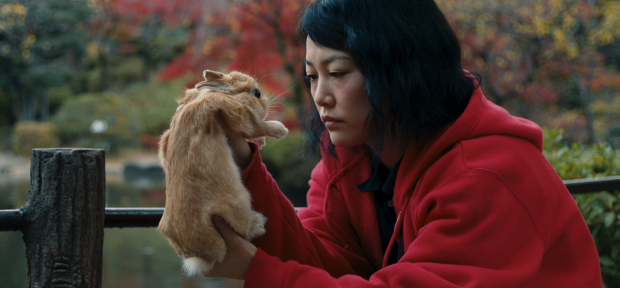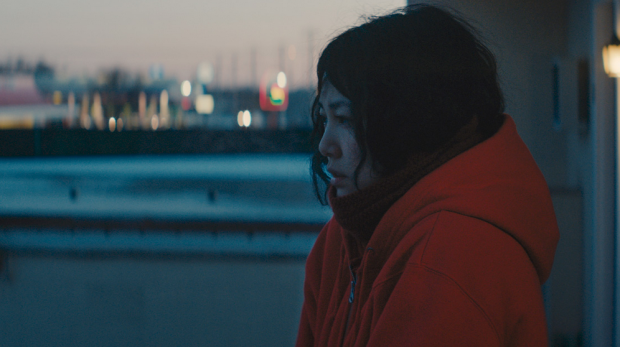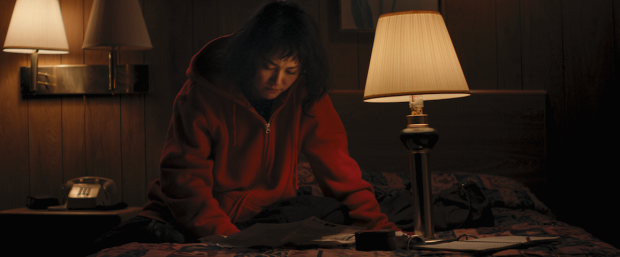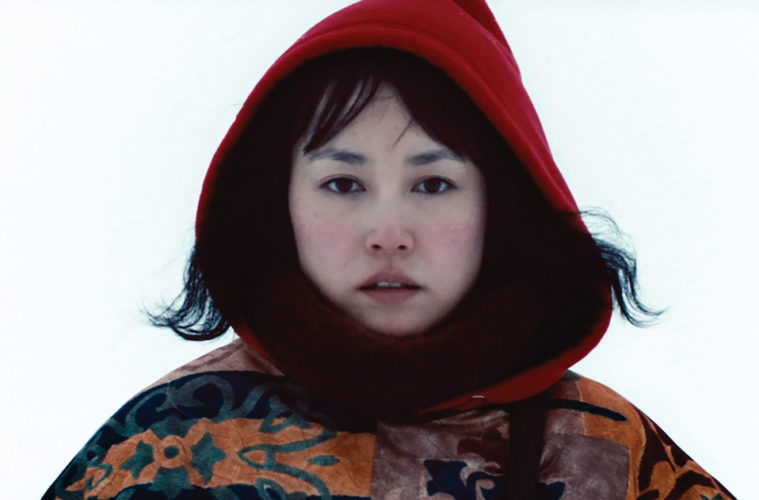
Kumiko, the Treasure Hunter has one of the most intriguing set-ups of any film to emerge in recent years: what if that eerie urban legend about the woman who, upon seeing Fargo and taking its “THIS IS A TRUE STORY” card at face value, traveled to Minnesota seeking the money dumped by Steve Buscemi’s character — and, in a cruel twist of fate, died while searching for something that doesn’t exist — actually happened? So many questions emerge. Who was this person? What made them want to take the journey, and, past their known fate, how did they fare in a cold, foreign land?
David and Nathan Zellner, Kumiko‘s respective co-writer / director and co-writer / producer, have mined the story for quite a bit. It’s stirring as both a narrative concerning and a visual exploration of one woman’s deeply damaged mind, the intricacies of which are brought to vivid life by a lead performance from Rinko Kikuchi — perhaps never better than in here. Because it occupies so many different locations, emotional registers, and possibilities with regard to subjective / objective reality, speaking to them (Ms. Kikuchi via translator) about their film allowed for an open conversation that covers many grounds, After viewing such a particular piece of work — and I do very much think you should seek out Kumiko — one is likely to be caught in a similar discussion.
There are many places one could start in discussing this film. Since I’m talking to all three of you, it seems right to begin with a question that involves everyone. I’ve read and seen David discuss the experience of shooting in two very different locations, so I’m curious about actually finding spots that are both visually enticing and, work-wise, manageable.
David Zellner: Well, you know, we needed to shoot in real locations for this film. One, because it’s such a landscape-driven film; the locations are essentially characters, and we’re playing them off each other. You couldn’t fake one and not the other. It’s stylized, but we wanted to ground it with a certain authenticity. Then you can build the more fantastical elements on top of them. We knew we needed to shoot in Tokyo and Minnesota, and we had a different crew for each that was local.
Nathan Zellner: One of the first things, when we were scouting in Japan, that we liked about Tokyo and found unique is that it’s a lot quieter than you would expect.
DZ: [To Kikuchi] Doesn’t it seem quieter to you?
Rinko Kikuchi: I think so.
NZ: In a lot of Western films, when they depict Tokyo, it’s the neon and the crowds, and that stuff certainly exists, but that’s not what the whole city is about. The culture and traditions are all sort of obvious when you’re there, and so those were the kinds of things we wanted to focus on. When we were looking for locations, it was stuff that we hadn’t seen before in Western cinema. With Minnesota, it was, again, sort of embracing what was there, as opposed to finding some agenda — keeping our schedules flexible so we could find the weather that was ideal for certain scenes.
DZ: Which was terrible weather.
NZ: Yeah, it was terrible. And, you know, the landscapes, like what David said about “being a character”: just utilizing what was in front of you and seeking those things that we found unique and beautiful, even though they might be cold and wintery and kind of ugly by other people’s standards. It was the kind of thing that we were looking for.
I’m curious, Ms. Kikuchi, how the shifting in locations changes your performance — more specifically how your relationship with the character evolves.
RK: In Japan, Kumiko was very introverted; she was closed into herself. But after she arrived in Minnesota, she really came alive, and she was very much moving towards her goal, towards a direction. She was more outwardly oriented. Yes, it was brutally cold, and so there were issues that were brought on by the cold — but, in other ways, she was so much more alive when in Minnesota, even though she had the cold to deal with.

One of the fun challenges Kumiko presents is, in some sense, actually rather simple: determining what year it’s set in. There’s something like an accounting book that tells you —
DZ: It’s a magazine. [Laughs]
NZ: Oh, yeah — a magazine in the background. Well, we didn’t want to put an exact year on it, but the urban legend came out in 2001, and we started writing it not long after that, so it’s more or less… even though we don’t beat the point home with a date, it just seemed like an interesting time to set it. Also, we like the tactile quality, and, growing up as VHS kids, that was something that we liked.
Around 2001 was kind of the transition from VHS to DVD. It was timely and it lent itself to the story. Also, we like the really ugly murkiness of an old VHS tape. There’s a mysterious element to that in this context, and also something about the organic distortion of it. So we liked the progression of extracting some vague truth out of that.
It’s funny, because, assuming it was set in the present day, I kept being distracted by asking, “Why is she watching a VHS tape?” Tell me about the intricacies that come with exploiting a period for things such as that — the tactility of a VHS tape, for instance — without stating anything that’s obvious and period-specific. Is this a really difficult thing?
DZ: No. It didn’t feel like it. It was just kind of intuitive. We didn’t want to put a year on the screen, or anything like that that kind of pulls you out of it. This isn’t that kind of film, and I think, sometimes, those things don’t really matter. It’s more of just getting a sense of a certain time or place, and the facts about the exact day and time aren’t always so pertinent… so I don’t know. Does that answer it?
 Sure. Another subtlety concerns her performance, which is communicated via gestures and glances. Maybe you can’t write it down so easily, or only have some idea of it, but this seems like the kind of thing that only truly blossoms once someone is in front of a camera. I’d care to know about building something from that point up.
Sure. Another subtlety concerns her performance, which is communicated via gestures and glances. Maybe you can’t write it down so easily, or only have some idea of it, but this seems like the kind of thing that only truly blossoms once someone is in front of a camera. I’d care to know about building something from that point up.
DZ: Just in terms of our end of it, we’re very visual with the scripts, from an aesthetic standpoint. Also, she’s by herself a lot. One of our favorite things, which seems so seldom in film, is getting to see somebody thinking. You know? That’s all cut out, and that’s the most human thing you could do, is to see someone process information. And so some kind of lazy voiceover or “internal monologue” sort of thing… we wanted to find a way to communicate through her body language, her gestures, her actions, through her pensive state.
And so we tried to make that as clear as we could, in terms of a foundation to work off of, what she’s internalizing, and then using that as a backbone — and based on what comes up naturally in the making of the film, and what Rinko brings to the table with it, we leave room for that stuff to breathe.
I guess I’d pose a question to the actress herself, then. How different was reading this screenplay vs. actually playing her in body language, with something more expressive?
RK: This is the task of taking something that’s in a script and making it three-dimensional. What role does she play in society? What are her interests? What is her outlook? How did she become who she is now? What happened to her, in her past, that made her who she is today, at this moment? That’s the kind of thing that was going through my mind as I was trying to act the role.
I read that you were first approached about the film several years ago. It feels so internalized, so I’d love to know how (or if) you held on to the character through all that time, and if there was thus a long process in bringing her out.
RK: I was waiting for it! I think it was somewhere in my head the entire time, because, ever since I read it, I knew there was the potential I would do it, and I think there was always somewhere in my mind where I was mulling it over, one way or another.
DZ: One of the things about her performance is that I think a less-confident actor would feel the need to oversell certain emotions or expressions or information, and then it would come out as a very false performance. What was so great about Rinko is that she was very confident and comfortable in that role and really owned it, and knew that she could be truthful to that character and let things happen naturally, and that people would be able to connect and resonate. If it was done any other way, it would’ve felt very false.
Something else that, incidentally, relates to a long build-up between conception and execution: I read that, when you were growing up, a lot of middle-aged women would have copies of Shogun in their house —
[All laugh]

DZ: In the ‘70s, there was… well, also, compared to globalization and the Internet, information was more limited in terms of other cultures and whatnot. So, in the ‘70s — when we were little kids — old white people had Shogun, and that was in the age of the miniseries, too. That was their way to be an authority on Japan, even though they probably didn’t read the book. They just thought, “I’ve got Shogun. I know what Japan’s all about.” Even when we were kids, we knew that was bullshit! [Laughs]
That’s what adults were exposed to. Kids, I think, it was the Toho Godzilla movies and Shogun Warriors, and that was it. We knew that was such a limited wave of information, and several times I remember being at old people’s homes, and that was sitting out, just like, they were very proud of it — as though they were “people of the world” because they owned it.
NZ: Travel was more difficult back then, and, even nowadays, you can get on the Internet and talk to somebody in another country, so a lot of your cultural exposure — whether it was an interest in other cultures — was dictated by media and pop culture, to certain extents, so it was very filtered already through entertainment — an entertainment lens, as opposed to reality. So remembering that, it wasn’t anything to “add” to the script. It was sort of like a view of culture and how people get exposed to it.
DZ: Or appropriation.
NZ: Or appropriation of it, which is really the true expression, or exploration, of another culture as an influence.
One last thing: how did the Werner Herzog quote end up on the film’s poster? What’s your relationship with him, if anything?
DZ: Oh, he’s just the all-time favorite filmmaker. We did a screening in Los Angeles that Sundance put together, and Sundance has been more supportive of us than anyone for over a decade — they’ve been so great — and they put together a screening, and Herzog came on as a moderator, and thankfully really responded to the film, which meant a lot to us. It was great.
And then your distributor or marketing team just took a line and put it on there?
NZ: He came up at the end and talked about it. He had a lot of insightful things. He watched the film and had —
DZ: He had a lot of eloquent and thoughtful things to say! [Laughs] It was really special.

Kumiko, the Treasure Hunter enters a limited release on Wednesday, March 18 in New York and on Friday, March 20 in Los Angeles.

